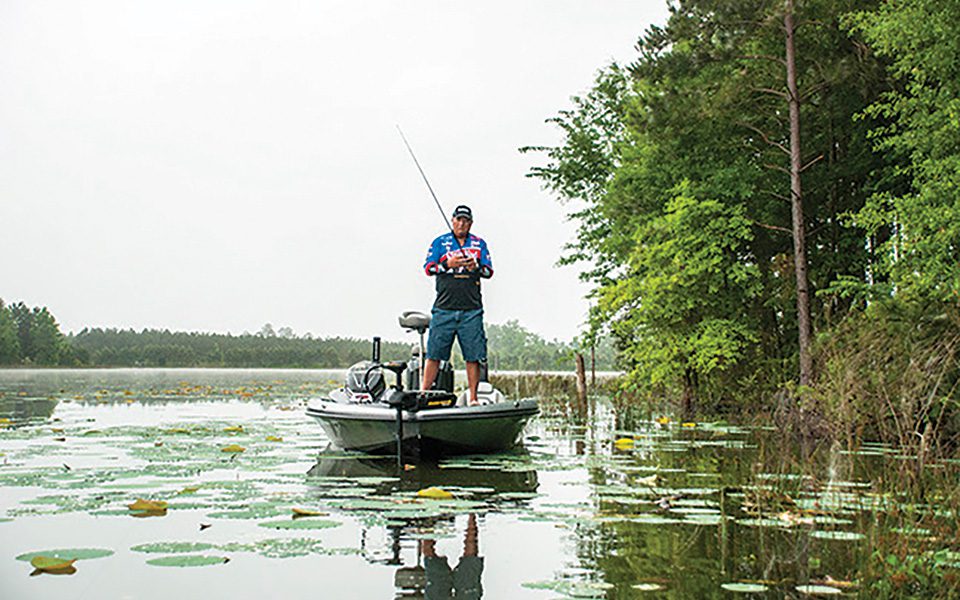Flipping is a must-know bass fishing technique that can put fish in the boat when everything else fails.
“Almost every lake has heavy cover, and where do the big bass like to live? They like to live in that heavy cover,” said bass pro Denny Brauer. “Conventional casting techniques often cannot get your bait in there, and if you can get your bait in there, your odds of getting the fish out are pretty slim. That’s where flipping comes into play.”
How to Flip
Hold your arm straight out and make sure the bait is even with the reel. This gives you about an arm’s length of line that’s easy to work with. Then, swing the bait out, but don’t just let go of the line or you’ll splash the bait into the cover, often spooking the fish.
“What you’re trying to do is let the line slide through your hand, bringing your hand back to the reel handle. Now you let your lure fall on just a little bit of slack line, that way the lure will fall straight down into the cover,” Brauer said. “When it hits bottom shake it a couple of times and now is the time to feel it—if it feels heavy or light, you need to set the hook. If not, pull the bait out and flip it into the next good-looking spot and repeat the process.”
Flipping Must-Haves
When it comes to flipping and pitching, the right equipment is incredibly important. For Brauer, that’s the Lew’s HyperMag Speed Spool SLS. Incredibly light and compact, it has a strong 20-pound drag for hooksets and pulling fish out of cover. It also has a perforated spool so you can tie direct with braid without slippage. He pairs it with a Team Lew’s Speed Stick 7’6” heavy-power Flipping rod.
“No matter what baitcasting reel you’re using, make sure you tighten that drag down as much as you can so you can get the hookset and get those fish out of heavy cover. It’s very important to have a reel that’s heavy duty because you’re going to be using a heavy rod and heavy line along with it, and the reel needs to be able to hold up,” Brauer said.
Line is also crucial. Brauer went to work with Seaguar to develop FLIPPIN lines in both braid and fluorocarbon. The braid is available in 50 and 65 pound.
“I love to fish the braid down through the heavy cover—matted grass, heavy vegetation, etc. because it’ll cut right through it, you get a great hookset, and there’s no stretch to it,” Brauer said. “So you get a really good hookset and you bury the hook really good.”
The fluorocarbon is useful for clear water and isolated cover. It is available in 20-, 25- and 30-pound test.
Where to Flip: Pattern Within the Pattern
Brauer’s advice is just to get out on the water, target some cover, and wait for that first bite, after which you can work toward discovering what he calls the “pattern within the pattern.”
Often he starts flipping boat docks. He fishes each pier, walkway, ladder, rope, boat lift and anything else in the water. Once he gets a bite, he analyses the spot, looking for a pattern.
“How deep of water are you sitting in? Is it a gravel bank or a mud bank? Is the dock on a point or back in a pocket? Those fish will tell you a lot if you pay attention,” Brauer said. “Was it on the shallow side of the dock? The deep corner? Was it on the windy side or the calm side? If you’re fishing a river, was it on the up-current side or the down-current side? The details you can pick up go on. And that’s what I call developing the pattern within the pattern.”
And when he’s flipping bushes, flooded buck brush, willow trees, cypress knees, etc., he’s constantly trying to figure out what side of the target fish are positioning on. If he can figure out how they’re positioned, he only has to make one flip to the target, which saves time.
“Once I’ve narrowed it down to what side the fish will be on—windy, sunny, shady—I then take it one step further,” Brauer said. “When you flip it in there and get that bite, ask yourself did the fish hit it on the drop or after it was on the bottom and was I shaking it up and down? Because if a fish hits on the drop, the fish is aggressive. If he hit it on the drop and your bait hits bottom, there’s no need to sit there and jig it up and down. Hit the next piece of cover.”
Conversely, there are times when you might need to jig repeatedly up and down, like after cold fronts or on heavily pressured waters. That might also be part of the “pattern within a pattern” that you discover.
Boat Control
It’s important to operate with the bow into the wind or current when flipping, operating your trolling motor to work targets efficiently.
“That way you can be going the speed you want to rather than the conditions pushing you too fast or slow,” Brauer said. “Also, working into the wind or current allows your boat to fall back when you catch a fish, giving you a second chance to approach the spot for another bite.”
Boat control also helps reduce the presence of your shadow in potential fish-holding areas. And, if the water is clear, you might want to back the boat off a bit and make pitches.

